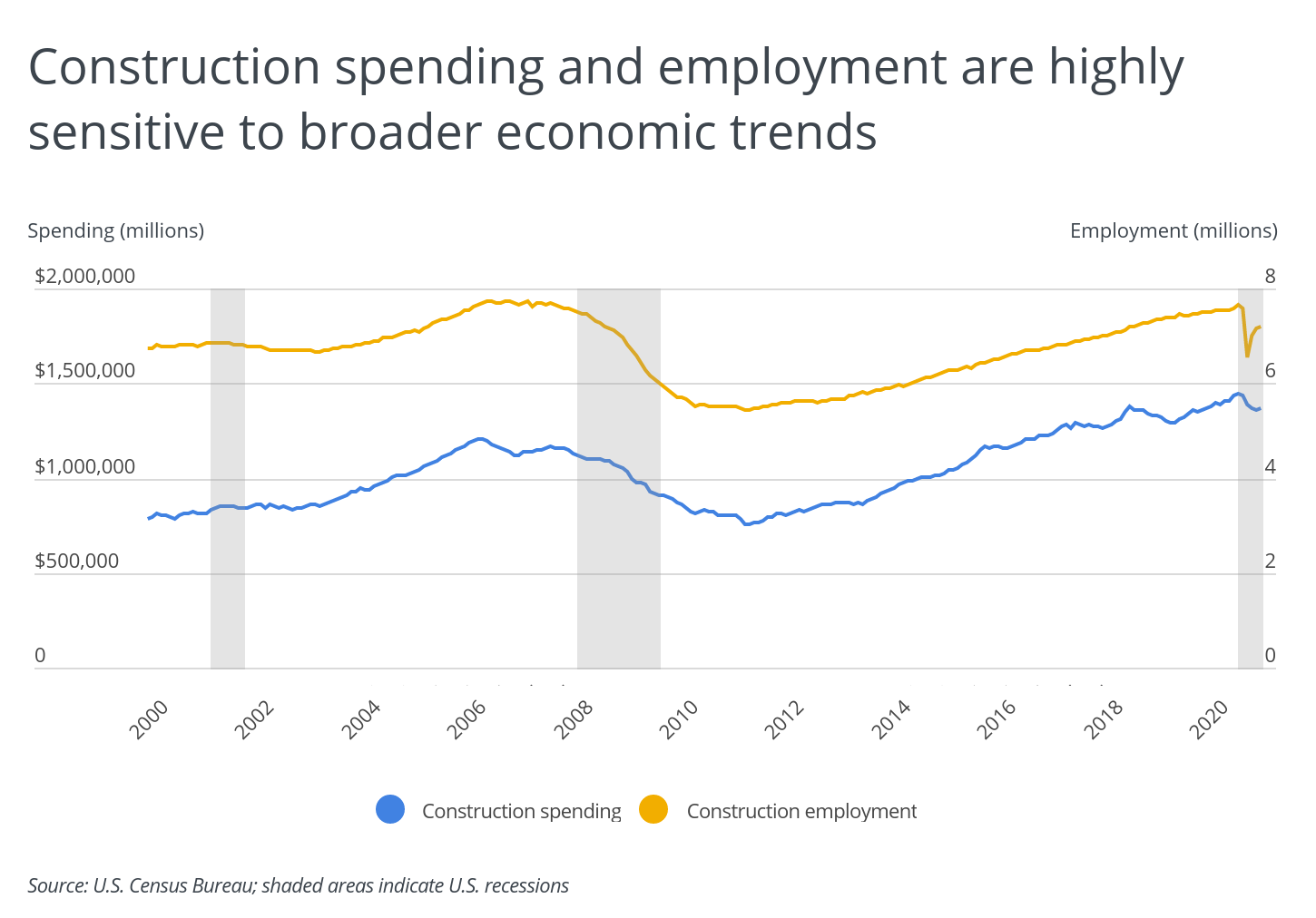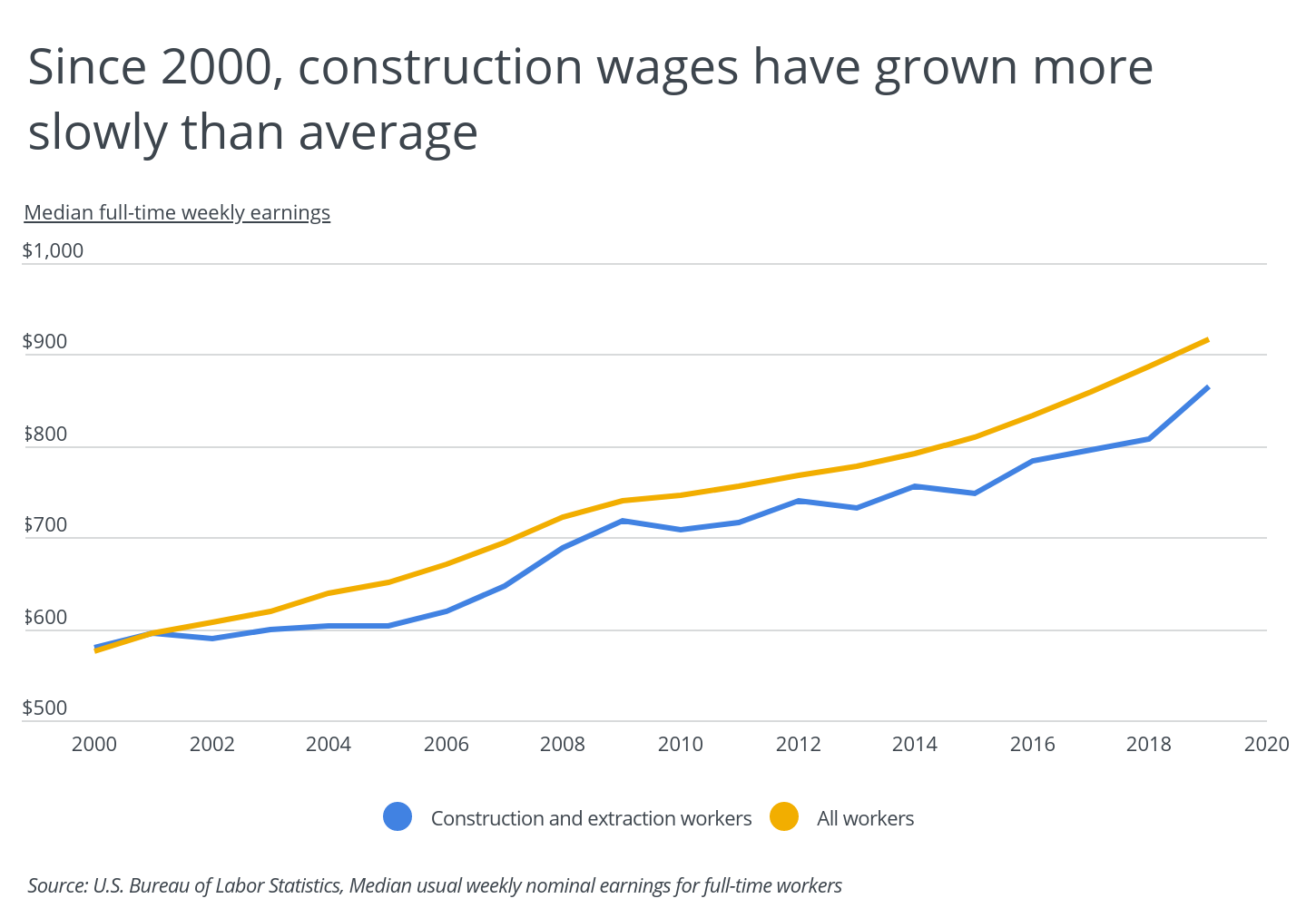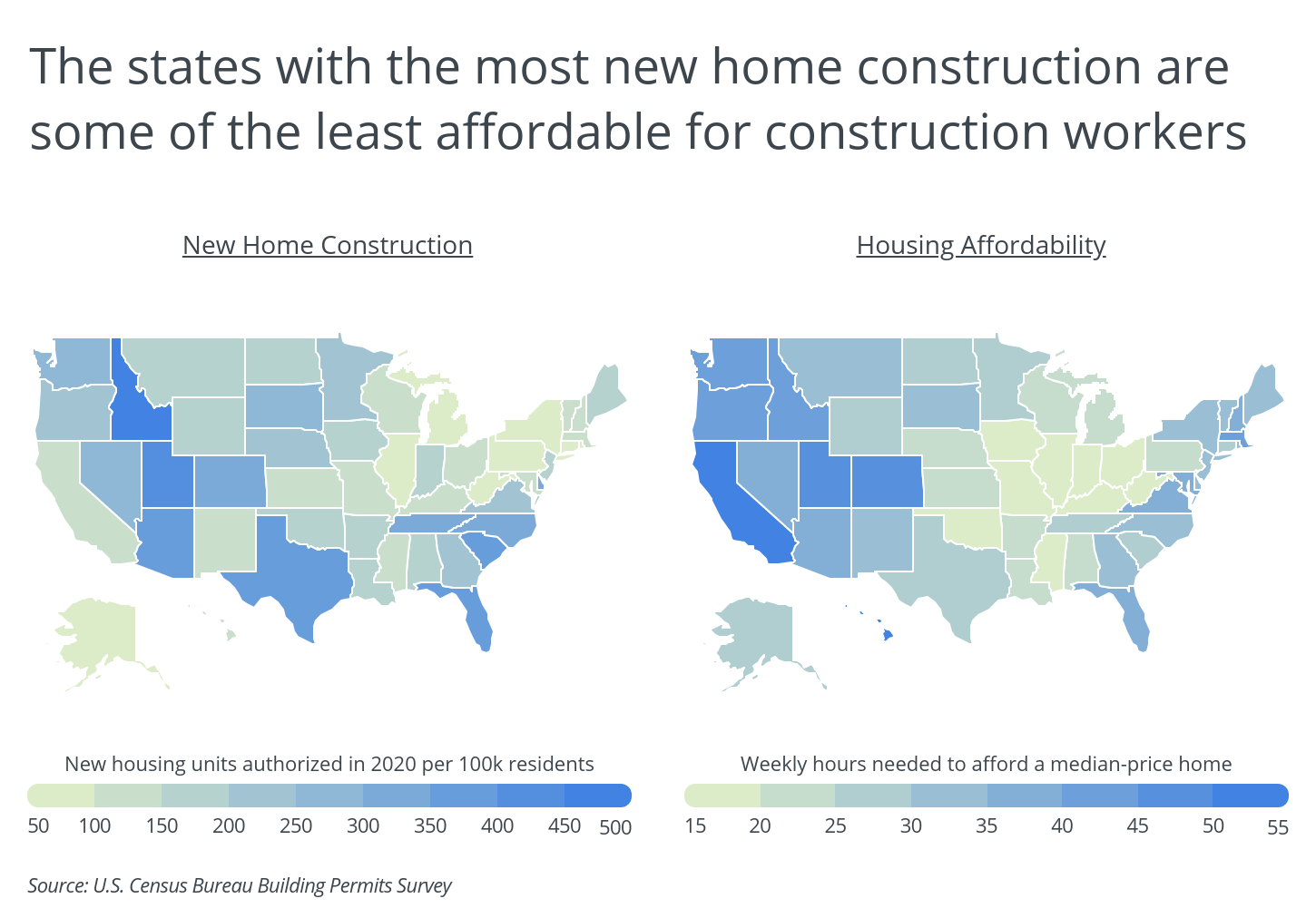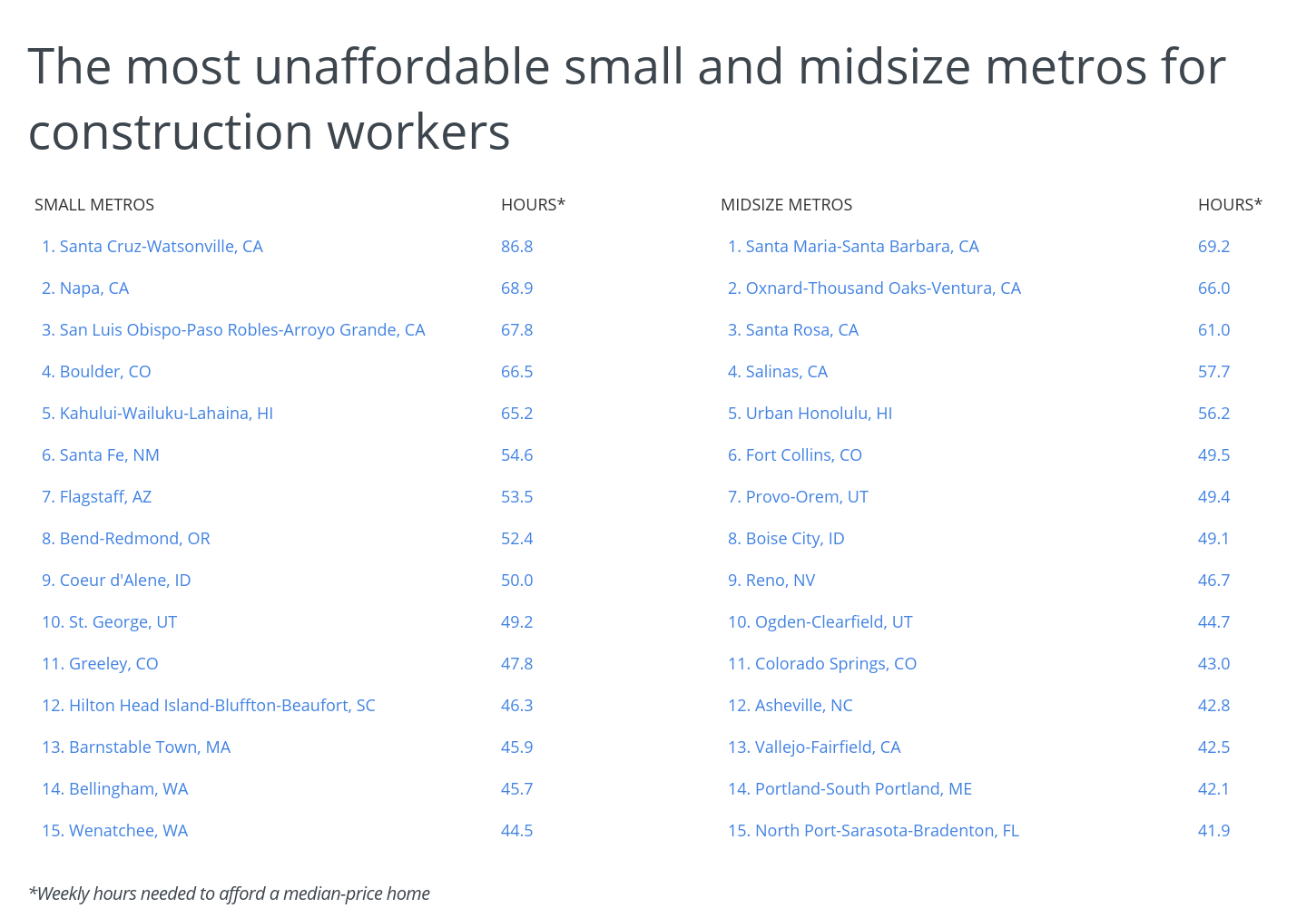The COVID-19 pandemic has precipitated dramatic fluctuations in the housing market. According to Freddie Mac, mortgage interest rates are near historic lows. U.S. Census Bureau data also shows that after a sharp decline in the first half of 2020, sales of new single-family residences were up 36.3 percent year-over-year in July. As sales have gone up, and inventory lags demand, prices in some cities have risen dramatically. Unfortunately, in many of these cities, construction workers—the people building the new supply of homes—are being priced out of the housing market.
Construction employment is highly sensitive to macroeconomic trends. For example, construction spending and construction employment saw significant drops both during the height of the Great Recession from 2009 to 2011 and at the onset of the COVID-19 pandemic in 2020. Both construction spending and employment had been trending upward over the past decade, prior to the outbreak. As of July 2020, the seasonally-adjusted annual rate of construction spending declined to $1.36 trillion from its peak of $1.44 trillion in February 2020. In the same time frame, construction employment decreased from 7.6 million workers to 7.2 million workers.

Even with a growing demand for construction in recent years, wages for construction workers have grown more slowly than overall wages for all occupations. According to the U.S. Bureau of Labor Statistics (BLS), in 2000 the median wage for full-time construction workers was $580 per week, compared to $575 per week for all full-time workers. As of January 2019, the median wage for construction workers was $866 per week compared to $917 for all workers, signaling a slowdown in construction wage growth.

Despite construction worker wages falling behind slightly, the typical construction worker in the U.S. still earns enough hourly to afford a home, assuming they have consistent work. According to the Zillow Home Value Index, the median price of a home in the U.S. is $253,527, which equates to a monthly mortgage payment of roughly $900. Data from the BLS shows that the nationwide median hourly wage for construction workers is $22.80 or $47,430 per year working full-time. Assuming that a homeowner spends no more than 30 percent of their income on mortgage payments, a construction worker would need to work just over 30 hours per week year round in order to afford a median-price home in the U.S.
However, median wages, home prices, and housing inventory vary significantly by location, and construction workers often struggle to maintain consistent employment. States in the West and the Northeast tend to have the least affordable housing for construction workers, while the Midwest and South are generally more affordable. In California, for example, a construction worker making the median wage would need to work 58.1 hours per week in order to afford a median-price home in the state. By contrast, a typical construction worker in West Virginia would only need to work 13.1 hours per week to afford a median-price home.
Interestingly, the states where home construction is booming tend to be less affordable for construction workers. According to the U.S. Census Bureau’s most recent Building Permits Survey, Mountain states such as Idaho and Utah have had more than 400 new housing units authorized per 100,000 residents in 2020, the highest among all states. However, construction workers in these states would need to work 44.3 and 46.7 hours per week, respectively, in order to afford a median-price home.

TRENDING
Installing gutters by professionals helps to prevent mold and mildew in and around your home. Use Porch’s cost calculators to learn everything you need to know about gutter installation cost as the cold weather approaches.
At a more local level, some individual metro areas are even more out of reach for potential homeowners who work in construction. To find the least affordable metro areas for construction workers to buy a home, researchers at Porch analyzed median wage data from the BLS’s Occupational Employment Survey and median home prices from the most recent Zillow Home Value Index. Metros were also categorized into the following cohorts based on population: small (100,000–349,999), midsize (350,000–999,999), and large (1,000,000 or more).
Similar to the statewide trends, home prices in metro areas in the West and the Northeast are most likely to be unaffordable for construction workers. Here are the most unaffordable metros for construction workers looking to buy a home.

The most unaffordable large metros for construction workers

Photo Credit: Alamy Stock Photo
15. Portland-Vancouver-Hillsboro, OR-WA
- Weekly hours needed to afford a median-price home: 42.0
- Median home price: $425,758
- Approximate monthly mortgage payment: $1,511
- Median hourly wage for construction workers: $27.66
- Median annual wage for construction workers: $57,540
RELATED
Looking to do a home renovation project? Find costs for carpet installation, drywall installation, wood privacy fence and more projects on Porch.

Photo Credit: Alamy Stock Photo
14. Riverside-San Bernardino-Ontario, CA
- Weekly hours needed to afford a median-price home: 43.2
- Median home price: $395,370
- Approximate monthly mortgage payment: $1,403
- Median hourly wage for construction workers: $25.00
- Median annual wage for construction workers: $52,000

Photo Credit: Alamy Stock Photo
13. Miami-Fort Lauderdale-West Palm Beach, FL
- Weekly hours needed to afford a median-price home: 43.7
- Median home price: $308,522
- Approximate monthly mortgage payment: $1,095
- Median hourly wage for construction workers: $19.28
- Median annual wage for construction workers: $40,090

Photo Credit: Alamy Stock Photo
12. New York-Newark-Jersey City, NY-NJ-PA
- Weekly hours needed to afford a median-price home: 44.6
- Median home price: $491,993
- Approximate monthly mortgage payment: $1,746
- Median hourly wage for construction workers: $30.09
- Median annual wage for construction workers: $62,590

Photo Credit: Alamy Stock Photo
11. Sacramento–Roseville–Arden-Arcade, CA
- Weekly hours needed to afford a median-price home: 46.2
- Median home price: $439,664
- Approximate monthly mortgage payment: $1,560
- Median hourly wage for construction workers: $25.96
- Median annual wage for construction workers: $54,000

Photo Credit: Alamy Stock Photo
10. Boston-Cambridge-Newton, MA-NH
- Weekly hours needed to afford a median-price home: 46.4
- Median home price: $508,747
- Approximate monthly mortgage payment: $1,805
- Median hourly wage for construction workers: $29.92
- Median annual wage for construction workers: $62,240

Photo Credit: Alamy Stock Photo
9. Salt Lake City, UT
- Weekly hours needed to afford a median-price home: 47.3
- Median home price: $399,291
- Approximate monthly mortgage payment: $1,417
- Median hourly wage for construction workers: $23.05
- Median annual wage for construction workers: $47,950

Photo Credit: Alamy Stock Photo
8. Seattle-Tacoma-Bellevue, WA
- Weekly hours needed to afford a median-price home: 49.4
- Median home price: $551,311
- Approximate monthly mortgage payment: $1,956
- Median hourly wage for construction workers: $30.47
- Median annual wage for construction workers: $63,370

Photo Credit: Alamy Stock Photo
7. Austin-Round Rock, TX
- Weekly hours needed to afford a median-price home: 50.1
- Median home price: $353,051
- Approximate monthly mortgage payment: $1,253
- Median hourly wage for construction workers: $19.22
- Median annual wage for construction workers: $39,970

Photo Credit: Alamy Stock Photo
6. Denver-Aurora-Lakewood, CO
- Weekly hours needed to afford a median-price home: 51.0
- Median home price: $455,591
- Approximate monthly mortgage payment: $1,616
- Median hourly wage for construction workers: $24.39
- Median annual wage for construction workers: $50,730

Photo Credit: Alamy Stock Photo
5. Washington-Arlington-Alexandria, DC-VA-MD-WV
- Weekly hours needed to afford a median-price home: 51.6
- Median home price: $447,416
- Approximate monthly mortgage payment: $1,587
- Median hourly wage for construction workers: $23.67
- Median annual wage for construction workers: $49,220

Photo Credit: Alamy Stock Photo
4. San Diego-Carlsbad, CA
- Weekly hours needed to afford a median-price home: 65.9
- Median home price: $639,238
- Approximate monthly mortgage payment: $2,268
- Median hourly wage for construction workers: $26.47
- Median annual wage for construction workers: $55,070
TRENDING
Trust Porch’s cost calculator to show how much it would cost to install kitchen cabinets in your home.

Photo Credit: Alamy Stock Photo
3. Los Angeles-Long Beach-Anaheim, CA
- Weekly hours needed to afford a median-price home: 70.7
- Median home price: $696,601
- Approximate monthly mortgage payment: $2,471
- Median hourly wage for construction workers: $26.89
- Median annual wage for construction workers: $55,940

Photo Credit: Alamy Stock Photo
2. San Francisco-Oakland-Hayward, CA
- Weekly hours needed to afford a median-price home: 93.5
- Median home price: $1,119,628
- Approximate monthly mortgage payment: $3,972
- Median hourly wage for construction workers: $32.69
- Median annual wage for construction workers: $67,990

Photo Credit: Alamy Stock Photo
1. San Jose-Sunnyvale-Santa Clara, CA
- Weekly hours needed to afford a median-price home: 110.5
- Median home price: $1,211,049
- Approximate monthly mortgage payment: $4,297
- Median hourly wage for construction workers: $29.90
- Median annual wage for construction workers: $62,190
Methodology & detailed findings
Median wages for construction and extraction workers are from the U.S. Bureau of Labor Statistics’ Occupational Employment Survey. Median home prices are from the most recent Zillow Home Value Index.
To determine how many hours a construction worker would need to work in order to afford a home in their location, researchers assumed that the worker would spend no more than 30 percent of their income on their monthly mortgage payment. Monthly mortgage payments were calculated for a median-price home with a 30-year fixed rate mortgage (3.4 percent) and a 20 percent down payment.
Only metropolitan areas with at least 100,000 residents and available data from both Zillow and the BLS were included in the analysis. Additionally, to improve relevance, metros were grouped into the following cohorts based on population: small (100,000–349,999), midsize (350,000–999,999), and large (1,000,000 or more).
Since many of the areas with the most new home construction are also some of the most unaffordable, construction workers in these areas likely have to commute long distances or forego homeownership in order to find work. Unlike many other occupations where work can be performed remotely, construction requires workers to be present on-site, which dramatically limits the options for housing. As home prices and new home construction continue to evolve in response to the pandemic, construction workers may find themselves more attracted to locations that balance demand for construction work with affordability.




